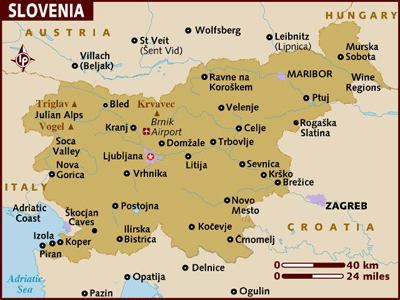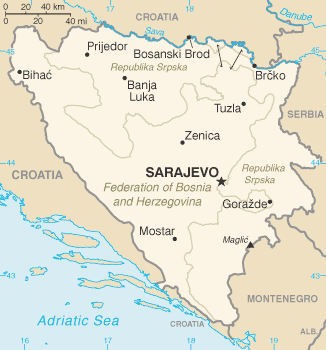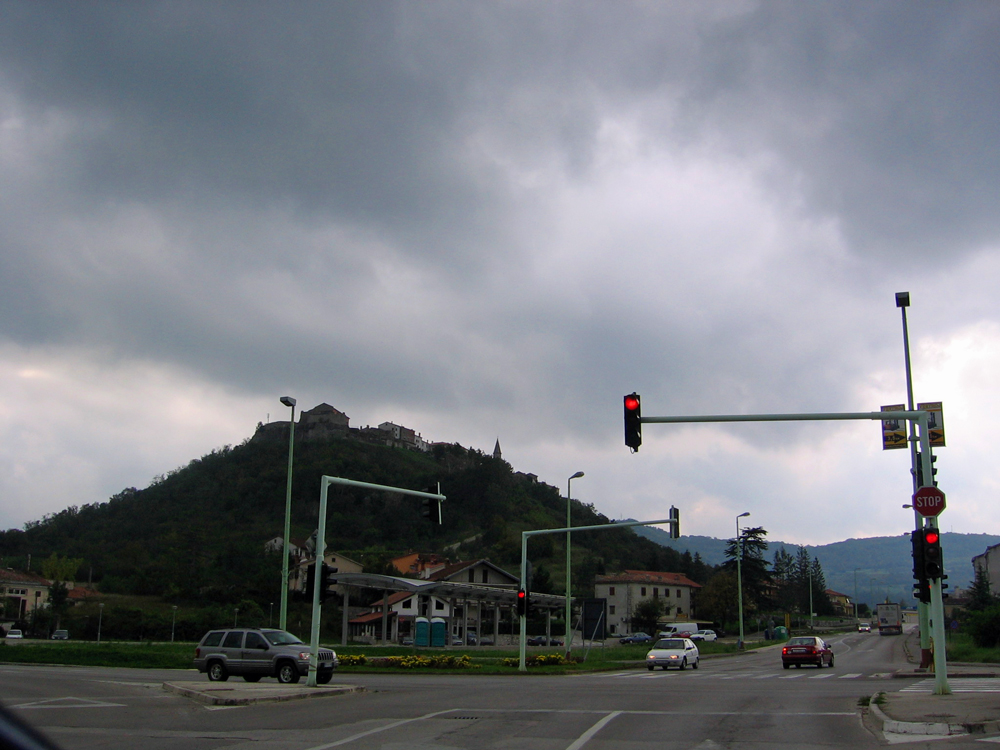|
Slovenia, Croatia and Bosnia-Herzegovina
4-6 Oct 2006
We leave Venice and make
a decision to head south along the Adriatic coast as opposed to north and
visit Austria....we'll
save the latter for the next life.
We cross the border from Italy into Slovenia at a
particularly poorly marked border at
Kozina. The crossing resembles a large deserted parking lot with a
nondescript 'gas station' in the far left corner and what resembles a
small shopping center on the right. l ignore the former and park at the
latter. As l climb out of the rentaracer, followed by a small flood of
'beverage' containers, l am met by a somewhat agitated Slovenian border
guard, armed with the requisite automatic weapon. Apparently we
have entered his two-bit country without going through 'customs'.
However, once l explain to him we are Canadians, he says he understands
and allows us to continue on our way. We pick up HW 7 and continue south
through the mountains.
 Slovenia
borders
Italy on the west, the
Adriatic Sea on the southwest,
Croatia on the south and east,
Hungary on the northeast, and
Austria on the north. Four major
European geographic regions meet in Slovenia: the
Alps, the
Dinarides, the
Pannonian Plain, and the
Mediterranean. The Alps dominate
Northern Slovenia along its long border with Austria. Slovenia's
Adriatic coastline stretches approximately 47 km (29 mi)[19]
from Italy to Croatia. On the Pannonian plain to the East and Northeast,
toward the Croatian and Hungarian borders, the landscape is essentially
flat. However, the majority of Slovenian terrain is hilly or
mountainous. Slovenia
borders
Italy on the west, the
Adriatic Sea on the southwest,
Croatia on the south and east,
Hungary on the northeast, and
Austria on the north. Four major
European geographic regions meet in Slovenia: the
Alps, the
Dinarides, the
Pannonian Plain, and the
Mediterranean. The Alps dominate
Northern Slovenia along its long border with Austria. Slovenia's
Adriatic coastline stretches approximately 47 km (29 mi)[19]
from Italy to Croatia. On the Pannonian plain to the East and Northeast,
toward the Croatian and Hungarian borders, the landscape is essentially
flat. However, the majority of Slovenian terrain is hilly or
mountainous.
Slovenia covers an area of 20,273
square kilometres and has a population of 2.06 million. The majority of
the population speaks
Slovene, which is also the country's
official language. Other local official languages are
Hungarian and
Italian..all of
which help us 'nada'.
Although Slovene history can be traced
back to the 8th century, Slovenia itself is a relatively modern
political entity, having been independent since 1991. During its
history, the current territory of Slovenia was part of many different
state formations, including the
Roman Empire, the
Frankish Kingdom, the
Holy Roman Empire, and the
First French Empire. During
World War Two, Slovenia was occupied
and annexed by Germany, Italy and Hungary, only to emerge afterwards
reunified with its western part (Slovenian
Littoral) as a founding member of the
Socialist Federal Republic of Yugoslavia,
before declaring full sovereignty in 1991.
The earliest signs of human settlement
in present-day Slovenia are two stone tools approximately 250,000 years
old. During the
last glacial period, present-day
Slovenia was inhabited by
Neanderthals; the most famous
Neanderthal archeological site in Slovenia is a cave close to the
village of
Šebrelje near
Cerkno, where the
Divje Babe flute, the oldest known
musical instrument in the world was found in 1995.
 We
uneventfully enter Croatia and take the A7 south along the Adriatic. The
highway and tunnels are fabulous, constructed with German engineering
and funding. We eventually get to Zadar where we decide to pack it
in for the night. We
uneventfully enter Croatia and take the A7 south along the Adriatic. The
highway and tunnels are fabulous, constructed with German engineering
and funding. We eventually get to Zadar where we decide to pack it
in for the night.
Zadar faces
the islands of
Ugljan and
Pašman, from which it is separated by
the narrow Zadar Strait. In the early 1990s the
Yugoslav wars began to devastate the
country and Zadar became a part of the new
Republic of Croatia. During the
Croatian War of Independence,
Krajina rebels (with the protection of
the serbianized
Yugoslav People's Army (under
Slobodan Milošević's control) converged
on the city and subjected it to artillery bombardment, in what is now
known as the
Battle of Dalmatia. Along with other
Croatian towns in the area, Zadar was shelled sporadically for several
years, resulting in damage to buildings and homes as well as
UNESCO protected sites. A number of
nearby towns and villages were also attacked, the most brutal being the
Škabrnja massacre in which 86 people
were killed.
We decide to stay at the Hotel Donat,
located in the Borik resort complex, for the evening. Our first
thoughts are that we have stumbled in the 1980s by mistake as we now are
staying at what we later we refer to as the 'Heroes of the Soviet
Republic Pleasure Hotel Number 49"....where you are ordered to have a
good time. The complex is very militaristic, even for Jim and I,
with 3 buildings that share a common mess hall. Once we've entered
the main building we face a check-in desk that must be close to 100 ft
long, albeit with 2 staff clustered around a mid 80s PC at one end. The
main floor of the hotel is enormous and faces a swimming pool and the
Adriatic, which gives us some hope the place is not going to make us
field strip an AK for supper. The staff is extremely courteous and
very fluent in English....and very, very apologetic for some reason.
We are a bit suspicious of their behaviour as a few Croats had run into
a Canadian battle group during the war that did not end well for the
Croats, but this does seem to be the issue here: end product is that
they lower the already ridiculously low room rate and give us what turns
out to be a platoon-sized room for next to nothing. They also throw in a
free supper in the mess hall, which is soon closing.
We quickly move into our room and then
head 'double time' to the mess hall....errrr, dining room. The
place is cavernous, loud and full of poorly dressed Slavic tourists
wearing cardboard suits.....we can only imagine a Soviet motor rifle
regiment chowing down in here not too long ago. At first glance
the place has table after table piled sky-high with gorgeous fruit, meat
and pastries and all sorts of other stuff....which, oddly enough, we
quickly find to all taste the same. However, we quickly gravitate
to the endless beer and wine offering, which again suspiciously taste
pretty much the same as each other, but effectively masks the taste,
errr, none-taste, of the earlier mess chow. We imbibe....endless
wine and beer comes only a handful of times in one's life, and this is
Croatia, after all....
After dindins, we head out on the beach
which we follow north to a small bar....somehow, all of the wine glasses
we have borrowed from the mess hall end up ceremoniously on the bottom
of the Adriatic. We have a couple of beers in the local bars and
then head back to the shack.
We get up the next day and head to
Split. Again, the roads are great, the scenery better, and we get
some great shots along the way.
Split is a very agricultural
soviet-style port city with gloomy unimaginative architecture
and is the largest
Dalmatian city and the second-largest
urban centre in
Croatia. The city is located on the
shores of the
Mediterranean, more specifically on the
eastern shore of the
Adriatic Sea, spreading over a central
peninsula and its surroundings, with
its
metropolitan area including the many
surrounding seaside towns as well. An intraregional transport hub, the
city is a link to the numerous surrounding
Adriatic islands and the
Apennine peninsula, as well as a
popular tourist destination.
Split is also one of the oldest cities
in the area, and is traditionally considered just over 1,700 years old,
while archaeological research relating to the ancient
Greek colony of Aspálathos (6th century
BC) establishes the city as being several hundred years older.
The passenger seaport in Split, with its annual traffic
of 4 million passengers, is the third busiest port in the
Mediterranean, with daily coastal
routes to
Rijeka,
Dubrovnik and
Ancona in Italy.
We search for somewhere to spend the evening, but to
little avail. However, at one hotel, we 'luck out' as the manager allows
us to rent his loft out for the night. We pick up a couple bottles of
wine and head to the sea for supper. The scenery is beautiful and
l take many shots as night falls.
 We
then decide to head east into Bosnia and Herzegovina for a 'day
trip'....we had Canadian Forces friends who were stationed here during
the war. Heading south along the Adriatic on HW 8, we pass through
an aptly named community called Dugi Rat....this is my kind of town. We
then decide to head east into Bosnia and Herzegovina for a 'day
trip'....we had Canadian Forces friends who were stationed here during
the war. Heading south along the Adriatic on HW 8, we pass through
an aptly named community called Dugi Rat....this is my kind of town.
We leave Croatia at Arzano. The border
crossing resembled a scene from a bad post-Apocalyptic
movie.....everyone, except us, is armed to the teeth, in bad uniforms,
and is very big and angry. l am told to leave the vehicle to buy a
visa and end up in front of more big, large, angry guys with automatic
weapons. Somehow we sort out the visa and we are on our way to
Mostar.
Bordered by
Croatia to the north, west and south,
Serbia to the east, and
Montenegro to the southeast, Bosnia and
Herzegovina is
almost landlocked, except for
26 kilometres (16 miles) of
Adriatic Sea coastline, centered on the
town of
Neum. The interior of the country is
mountainous centrally and to the south, hilly in the northwest, and
flatland in the northeast. Inland is the larger geographic region with a
moderate
continental climate, marked by hot
summers and cold, snowy winters. The southern tip of the country has a
Mediterranean climate.
The country is home to three ethnic
groups:
Bosniaks, the largest population group
of the three, with
Serbs in second and
Croats in third. Regardless of
ethnicity, a citizen of Bosnia and Herzegovina is often identified in
English as either
Bosnian or
Herzegovinian. Formerly one of the six
federal units constituting the
Socialist Federal Republic of Yugoslavia,
Bosnia and Herzegovina gained its independence during the
Yugoslav wars of the 1990s.
Mostar (Cyrillic:
Мостар (how apropos) is situated on the
Neretva river and is the fifth-largest
city in the country.
The Old Bridge,
a 16th century
Ottoman
bridge
thoughtfully destroyed during the war, was rebuilt in 2004 and it
is one of the city's most recognizable landmarks. Between 1992 and
1993, after
Bosnia and Herzegovina declared
independence from
Yugoslavia, the town was subject to an
18 month
siege. Mostar was divided into a
Western part, which was dominated by the Croat forces and an Eastern
part where the
Army of the Republic of Bosnia and Herzegovina
was largely concentrated. After the war, the
ICTY accused the
Croatian Republic of Herzeg-Bosnia
leadership for the
crimes against humanity and other
war crimes during the war, including
the destruction of the
Stari Most bridge.
Every village enroute to Mostar has
nice houses alongside burned-out houses with bullet holes and the former
inhabitants buried in the garden. Signs along the highway
indicating that the surrounding ground is still mined are pleasant
reminders of former times and we pass at the opportunity to get blown
up.
Our stay in Bos is short and unpleasant
and we could not wait to leave....the gloomy, overcast weather pretty
much sums up our thoughts of the entire country. The high point of
the trip is passing a sailing ship-shaped house made out of
concrete....we'd have taken pictures but the aforementioned mines made
the thought unadvisable. Getting across the border into Croatia,
again staffed by very large, looming border guards, was very
welcoming, and we made our way back to Split.
We spent the rest of the day waiting
for the ferry that would take us back to Italy. There were a lot
of people moving around the terminal and we refrain from saying hello to
a bunch of clearly identified Canadians. When the time comes to board
the ferry, a large german SUV decides he wants to cut me off and board
the ferry ahead of us...to no avail. l pay his vehicle a visit once we
get on board.
Jim has booked us, at enormous expense,
a cabin with bunk beds and a window a foot thick and over 100 ft above
the Adriatic. Once the thought dawns on us that we are doing a night
crossing in a room we would never get out of alive if something bad was
to happen, we decide to kill the couple bottles of wine we have with us
and avoid any pretense of sleeping.
The resulting ride across to Ancona,
Italy, was uneventful but getting off the ferry and having to deal with
italian traffic with a belly load of Croatian wine made things
interesting for a while....
click on a
picture to see a larger image. hit arrows at either end of the slideshow
for more pictures.
heading south to Croatia and appropriately gloomy times Split again...waiting for the ferry back to Italy

heading south to Croatia and appropriately gloomy times
|